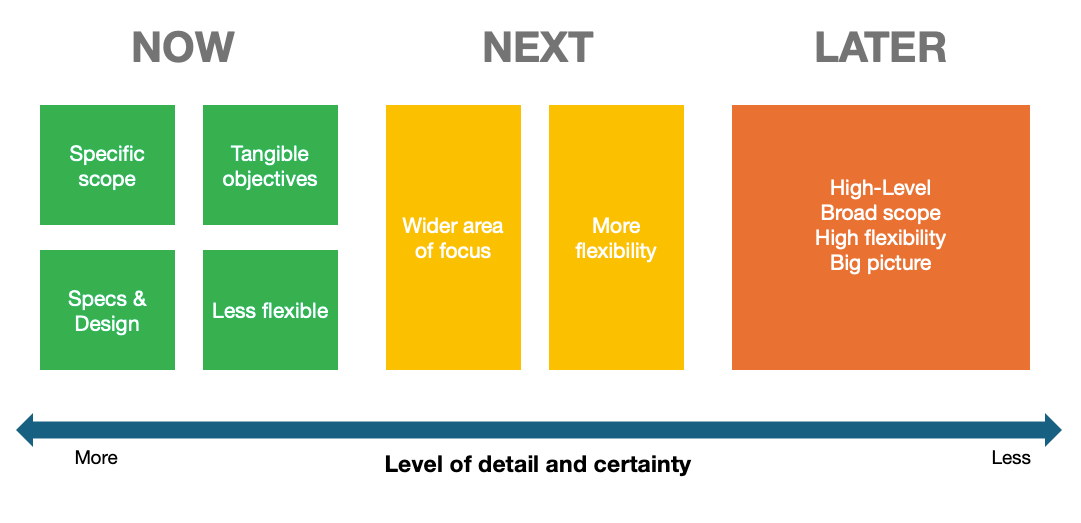Now-Next-Later Framework 🕒
The Now-Next-Later framework is a simple and flexible way to organize roadmap priorities by time horizons. It enables teams to balance short-term execution with long-term planning, ensuring focus on the most impactful tasks while adapting to change.
 The Now-Next-Later framework helps teams manage priorities without overcommitting to rigid timelines.
The Now-Next-Later framework helps teams manage priorities without overcommitting to rigid timelines.
What is the Now-Next-Later Framework?
This framework breaks down priorities into three distinct time horizons:
- Now: Work currently in progress, with a well-defined scope and high certainty.
- Next: Near-term priorities that are in planning but remain flexible.
- Later: Long-term ideas that are loosely defined and exploratory.
💡 Why it works: The framework balances clarity and adaptability, enabling teams to manage both short-term execution and long-term vision.
Breaking Down the Time Horizons
1. Now 🟩
- Characteristics:
- Specific, actionable tasks with detailed requirements.
- High certainty and low flexibility.
- Examples:
- Finalizing feature implementation.
- Fixing critical bugs.
- Mindset: “Let’s deliver this!”
2. Next 🟨
- Characteristics:
- Defined but flexible priorities.
- Wider areas of focus than “Now.”
- Examples:
- Researching potential solutions for upcoming features.
- Preparing designs or prototypes.
- Mindset: “What’s coming up next?”
3. Later 🟧
- Characteristics:
- High-level ideas with minimal detail.
- Maximum flexibility and low certainty.
- Examples:
- Exploring new market opportunities.
- High-level planning for product extensions.
- Mindset: “On the horizon.”
Benefits of the Now-Next-Later Framework
- Clarity: Provides a clear distinction between immediate, near-term, and long-term priorities.
- Flexibility: Allows teams to adjust focus as priorities evolve.
- Stakeholder Alignment: Simple to communicate, making it easier to align everyone on what’s happening now and what’s planned for the future.
- Focus on Value: Ensures that the team is always working on the most impactful tasks.
How to Implement the Framework
- Define Your “Now”
- List tasks and initiatives that are currently in progress and have a high level of detail.
- Ensure that the team is actively working on these items.
- Plan the “Next”
- Identify the priorities that will be tackled once “Now” items are completed.
- Maintain some flexibility for adjustments based on new insights.
- Explore the “Later”
- Use the “Later” section to capture long-term ideas and opportunities.
- Avoid overloading this section with unnecessary details—keep it high-level.
- Review Regularly
- Update the framework frequently to reflect changing priorities and evolving business needs.
- Move items from “Next” to “Now” and from “Later” to “Next” as they gain clarity.
Common Pitfalls and How to Avoid Them
- Overloading the “Later” Section
- Pitfall: Adding too many items that dilute focus.
- Solution: Keep “Later” lean, focusing on the most promising long-term ideas.
- Under-Defining the “Now” Section
- Pitfall: Including vague tasks that aren’t ready for action.
- Solution: Ensure that “Now” items are well-defined and actionable.
- Ignoring Stakeholder Feedback
- Pitfall: Using the framework as a siloed team tool without external input.
- Solution: Involve stakeholders to validate priorities and ensure alignment.
When to Use the Now-Next-Later Framework
This framework is ideal for:
- Teams working in fast-paced environments with shifting priorities.
- Roadmaps that need flexibility without losing focus.
- Stakeholders who prefer a high-level, time-based view of priorities.
Conclusion
The Now-Next-Later framework is a practical and adaptable approach for managing roadmap priorities. By balancing clarity with flexibility, it helps teams focus on delivering immediate value while keeping long-term goals in sight.